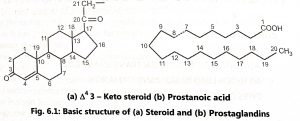Microbial Transformations
- Microbial transformation is a biological process in which organic compounds are modified into reversible products.
- These biotransformation reactions are catalyzed by purified enzymes present in microbial cells or pure cultures of microorganisms.
- Microbial enzymes are highly versatile in nature. Microorganisms are more adaptogenic and can develop new enzymes for metabolism.
- Microbial bioconversions are routinely used in the commercial production of steroids, antibiotics, vitamins, prostaglandins, citric acid, and many other therapeutic molecules.
- Steroids can be produced by chemical synthesis or by microbiological transformations. Steroids are physiologically active compounds that include progesterone, testosterone, cholesterol, ergosterol, corticosterone, etc.
- Steroidal hormones are known to be regulators of metabolism in the animal or human body. Prednisone and prednisolone are effective in the treatment of rheumatoid arthritis and progestogens and estrogens are used as oral contraceptives.
- Mamoli and Vercellone (1937) made the first successful microbial transformation of steroids. Peterson and Murray (1952) reported the 11-hydroxylation of progesterone using a fungi Rhizopus arrhizus.
- Steroidal transformations are mainly affected by bacteria, actinomycetes, and fungi. The structure of a basic steroid is shown in Fig.
- Prostaglandins are naturally occurring hormone-like substances derived biosynthetically from C-20 polyunsaturated fatty acids containing three or four double bonds.
- They are potent vasoactive substances that play a key role in regulating cellular metabolism. Structurally, prostaglandins are derivatives of prostanoic acid and have a Cyclopentane ring with two side chains attached to adjacent carbon atoms.
- The microbial transformations are commonly reported in different antibiotic classes such as β-lactam, peptide, macrolide, actinomycin, chloramphenicol, novobiocin, griseofulvin, anthracycline Pharmaceutical Biotechnology lincomycin, etc.

ADVANTAGES OF MICROBIAL TRANSFORMATIONS
Microbial transformations are brought about by enzymes secreted by selected strains of microorganisms. These reactions are essentially detoxifying mechanisms employed by microorganisms. Some of the other advantages are listed below:
- The microbial transformations react specifically. Side reactions do not occur if one enzyme is involved in biotransformation. The catalytic activity is usually restricted to a single reaction type.
- Microorganism catalyzing bioconversions act as a stereospecific catalyst i.e. specific microorganisms must be used to carry out a specific type of transformation.
- The substrate molecule is usually attacked at the same site, even if several groups of similar reactivity are present (regiospecificity).
- Microbial bioconversion reactions can be carried out under mild conditions such as neutral pH, room temperature, and at normal pressure.
- Biotransformation reactions can reduce the multistep chemical reaction to a single step.
- As compared to chemical reactions, microbial transformations require fewer chemicals, labor, time and money, and release good yield.
- Microbial transformation can selectively introduce functional groups at certain non-activated positions in a molecule, which can not be attracted by chemical reagents.
